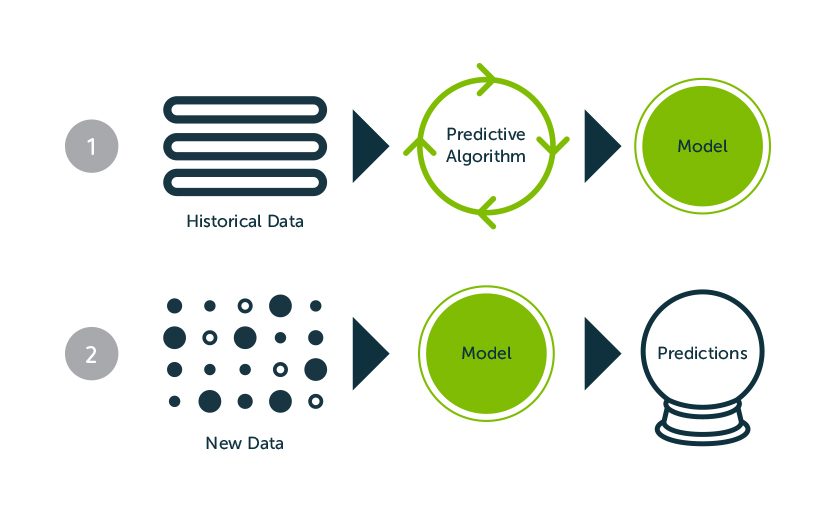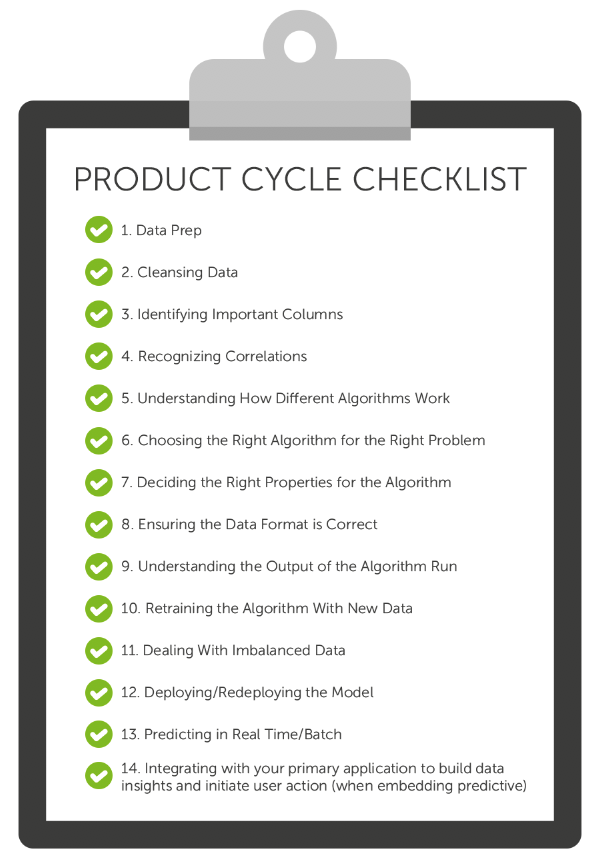The world’s favorite applications use predictive analytics to guide users—even when they don’t realize it. No wonder predictive analytics is now the #1 feature on product roadmaps, according to Logi’s 2018 State of Embedded Analytics Report.
Predictive analytics uses machine learning and historical data to tell you what’s coming, not just what happened. By embedding machine learning and artificial intelligence inside your application, you can empower your end users to make better decisions and take corrective action—and ultimately set your application apart from the competition.

What could predictive analytics do for your application? And how can you get started?
What Is
Predictive
Analytics?
At its core, predictive analytics answers the question, “What is most likely to happen based on my current data, and what can I do to change that outcome?” It uses historical data, machine learning, and AI to predict what will happen in the future. Historical data is fed to a mathematical algorithm that looks for trends and patterns in the data, and creates a model for it. The model is then applied to current data to predict what will happen next.

Why is predictive analytics on so many product roadmaps? Just imagine running a business without intelligent, data-centric business models. It’d be like taking a road trip using a paper map. You’ll get where you need to go, but you may have to keep pulling over to study a large, confusing map. It doesn’t adjust automatically to accommodate changes in traffic, and it won’t suggest which turn you should take next. With predictive analytics, you’re on the same road trip but with a built-in GPS navigation system guiding you to your final destination. It’s seamlessly embedded in your car, and automatically adjusts to traffic patterns, forecasts delays, and receives the real-time data you need to make informed decisions on your route.
How Does Predictive Analytics Relate to Artificial Intelligence, Machine Learning, and Deep Learning?
Artificial intelligence is an area of computer science that studies the ability of computers to perform tasks and functions that would typically require human intelligence, such as speech recognition or decision-making. AI learns by acquiring and then applying the knowledge to make new decisions. The aim of AI is to find the optimal solution by training computers to respond as well as—or better than—a human.
Machine learning relies on processing big datasets to find common patterns. Machines learn and acquire knowledge or skills through experience (or data). It has to do with the use of algorithms to identify and analyze patterns in data to predict future events.
Deep learning is a subset of machine learning which is most often applied to text, audio, photographic, or video data. Deep learning requires massive amounts of data to learn complex processes, such as distinguishing an image of a bicycle from that of a motorcycle.
Predictive analytics, also known as advanced analytics, uses machine learning, statistics, and historical data to predict future probabilities and trends. It also goes further than other machine learning tools by recommending actions that can affect future outcomes.
In a nutshell, machine learning and predictive analytics fall under the broader umbrella of artificial intelligence. Predictive analytics is an application of machine learning and artificial intelligence. In practice, an analytics tool produces a predictive score, which informs actions that end users should take.
What About Business Intelligence?
Business intelligence (BI) is the process of collecting business data and turning it into information that is meaningful and actionable in order to reach a strategic goal. Years ago, there was a pretty clear distinction between business intelligence and predictive analytics vendors. While BI was built with analysts and end users in mind, predictive analytics catered to data scientists. If an organization wanted to know which customers were likely to churn, they would purchase a BI product for the analytics capabilities and integrate it with a separately purchased predictive tool. This approach led to siloed systems with no way to communicate with each other.
As you can imagine, buying and maintaining two products for BI and predictive analytics is time-consuming and expensive. Now, forward-thinking analytics vendors are adding predictive capabilities to their BI products. Every application with BI and analytics can benefit from adding predictive analytics. It gives end users the ability to build and deploy predictive analytics models directly from their analytics applications—eliminating the need to use a second tool.
Predictive Analytics Is on the Rise
Consumer applications have included predictive analytics for years. If you’ve ever used a flight cost predictor like Google Flights or browsed through movie recommendations on Netflix, you’ve benefited from predictive analytics. The same goes for every time you’ve purchased an item from Amazon and then received an email suggesting other items you might like.
Predictive analytics has also made its way into business applications. In fact, it’s the #1 feature on product roadmaps, according to Logi’s 2018 State of Embedded Analytics Report. So many application teams are including predictive analytics capabilities in their software because of the enormous value it offers to end users and application teams alike.
What’s the Value of Predictive Analytics?
For end users, predictive analytics can give them insights and suggest actions that directly impact operations, revenue, and risk assessment. It applies to business applications for a wide range of use cases across various industries. Some scenarios include:
- Reducing customer churn: A sales application with predictive analytics could analyze regular customer behaviors and alert the sales professional when a customer is likely to churn out. Targeted promotions can then be deployed effectively.
- Detecting fraud: In finance, predictive analytics helps identify potentially fraudulent behavior before it happens. Banks can predict loan defaults, approve credit, or detect suspicious activities.
- Reducing machine downtime: Predictive analytics can improve production capacity and reduce downtime by analyzing historical and online data from production lines.
- Flagging high-risk healthcare patients: Hospitals and physicians can identify high-risk patients to prioritize for screening and recommend preventative treatments. This also consequently reduces hospital readmissions.
For businesses, adding machine learning and artificial intelligence into your application sets you apart from competition and allows end users to make better decisions, which in turn, gives you the opportunity to increase revenue. Over 90 percent of business leaders expect to see new business value from AI implementations in the coming five years, according to a recent survey from the MIT Sloan Management Review, in partnership with BCG Henderson Institute.
In Chapter 2, we cover more specific examples of these scenarios.
What Are the Top Challenges Around Predictive Analytics?
Predictive analytics is a complex capability, and therefore implementing it is also complicated and comes with challenges. When companies take a traditional approach to predictive analytics (meaning they treat it like any other type of analytics), they often hit roadblocks.
Top predictive analytics challenges include:
Statistical Modeling Expertise
Although predictive analytics is on the rise, traditional tools were developed for data scientists with a deep understanding of statistical modeling, R, and Python. Therefore, many application teams need the help of a data scientist (or several) to even begin using and incorporating predictive analytics into their software. Data scientists have an important role to play in analyzing data and recommending actions. Predictive analytics solutions can make them more efficient, productive, and scalable to solve new challenges.
Multi-Step Process
For every update and release, there is a long list of steps that are typically handled by a dedicated data scientist. This ends up being very burdensome to the application team and adds a significant amount of time to each product cycle. These steps include:

Insight Without Action
Predictive analytics tools tend to be standalone applications. This means that users need to toggle between multiple applications. While predictive analytics alone provides valuable insights and information, it fails to let users take immediate action—which interrupts workflow and adds unnecessary time.
Adoption
The more difficult and time-consuming a new technology is to learn, the less inclined end users are to adopt it. As discussed above, having to switch from one tool to another is a time-consuming and painful process.
What’s the Best Way to Address These Challenges?
Just like any other new feature or capability that you introduce through your software, if you want your end users to use it, you need to meet them where they are—in the applications where they already spend their time. If it lives as a standalone or separate tool, it will simply never get adopted.
That’s why predictive analytics is most effective when it’s embedded inside applications. Embedding machine learning and artificial intelligence inside your application empowers your end users to make better decisions and take corrective action—and ultimately sets your application apart from the competition.
To address challenges around user adoption, distribution of predictive analytics, and closing the insight-to-action gap, you need to embed predictive analytics directly into your application. This will allow end users to quickly and efficiently see what is going to happen in the future and subsequently act on it without leaving your application.
New embedded predictive analytics tools are emerging that are designed specifically for a range of users and do not require expertise in statistical modeling. Moreover, they help reduce the burden on application teams by streamlining a lengthy development.
